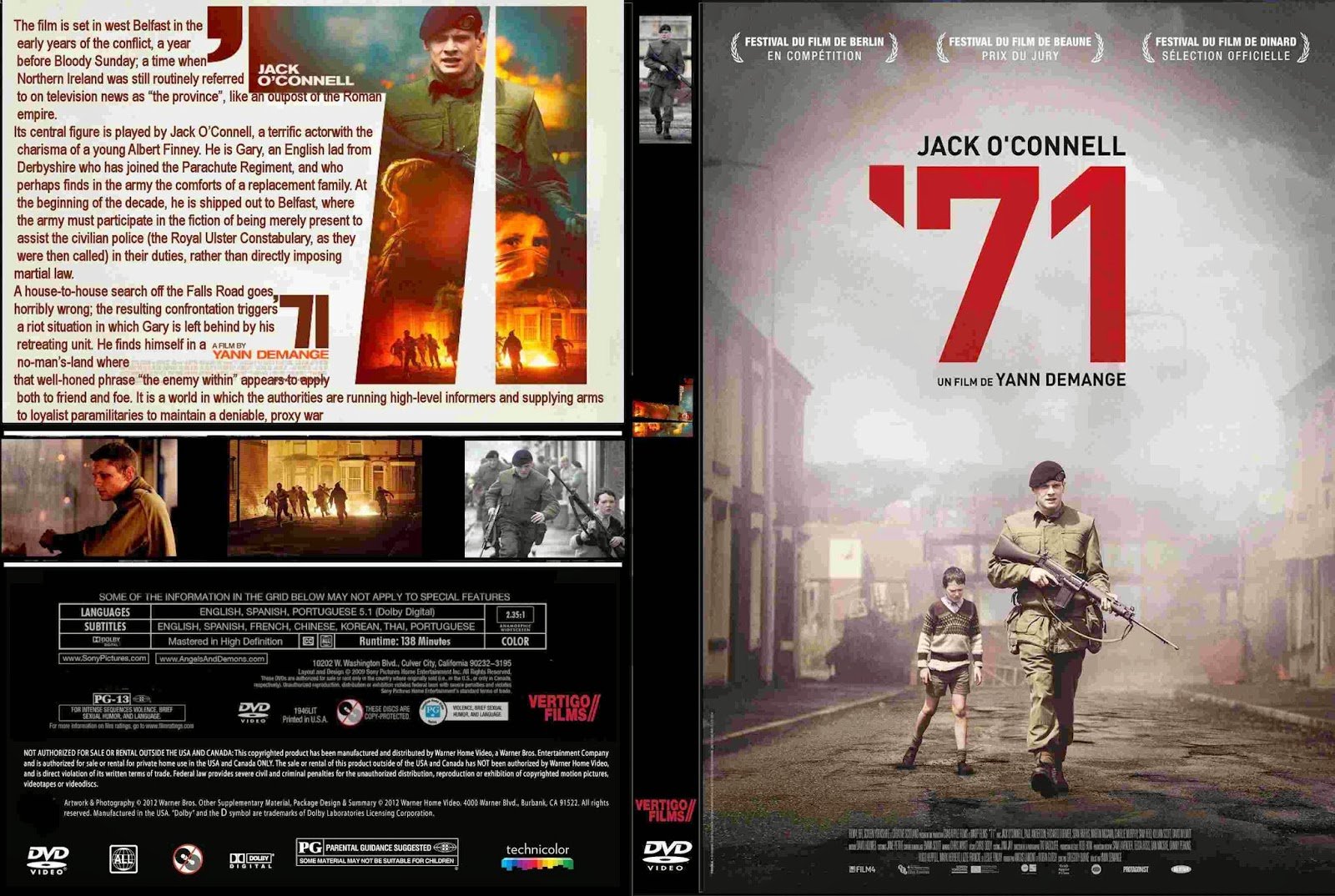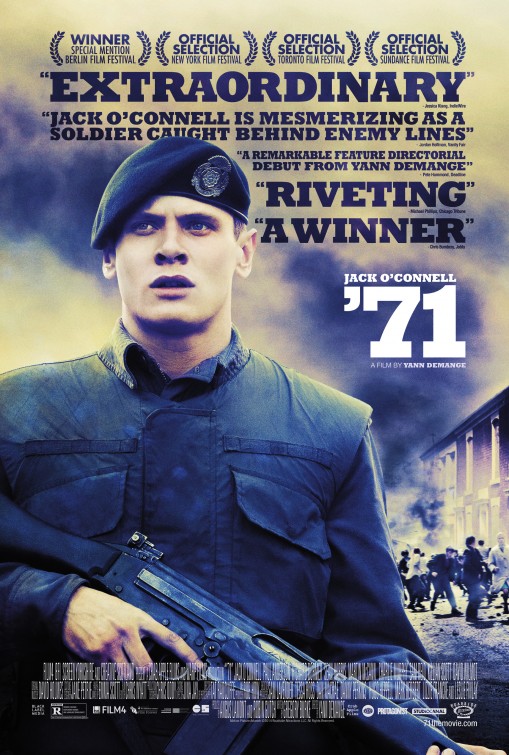''71''
The basics
1) What is the name of the film, the director and notable stars?
'71
Directed by Yann Demange
Starring Jack O'Connell, Sam Reid and Sean Harris
2) When was it released?
2014
3) What genre is the film? What are the generic conventions that tell you the film belongs to this genre?
Action, Drama, Thriller, War - The plot is based on the war in Belfast between British and Irish soldiers. It has faced past action sequences(chases). It contains scenes of explicit violence.
4) What was the critical reception? What is the film rated on IMDb or Rotten Tomatoes?
IMDb- 4.7/10
Rotten Tomatoes- 7.7/10
Broadcast
1) Write a close-textual analysis of the trailer using the MIGRAIN key concepts of Media Studies.
The trailer uses several conventions and iconography to reveal that it is a war movie. The props such as guns and the fast paced camera movements suggest that it is filled with action sequences and revolves around the theme of survival. In terms of the institution, the film links to one of Gillian Dyer's 13 lines of appeal- art, culture and history- as it it based around the conflict between the Catholics and Protestants in Ireland. The overall narrative structure is linear as it follows the main character and his fight for survival. The audience for this particular film would be predominantly male, and in the ABC1 social group. In terms of psychographics they would be succeeders or explorers. This is because the film is part of the arthouse genre and revolves around a specific historical theme in which only an educated audience would enjoy. The representation of British people in the film (in particular soldiers), is that they are brave and courageous. This is shown when the main character risks his life while being chased by angry Irish men. Levi Strauss' theory of representations in the media being informed by ideology could be used in this context as the film was made for the audience to favor the ''British side'- in other words, see the Irish as the villains and the British soldiers as the protagonists.
2) Find examples of television promotion on YouTube (adverts, chat shows, ‘red carpet’ interviews etc.) and post them to your blog along with an explanation of how these promote the film.
Yann Demange - Rec Carpet Interview
This interview was taken form the New York Film Festival- this shows us that the director of the film is trying to promote it internationally, as many people are ''cinema enthusiasts'' and are interested in the arthouse genre. It could also be a way of promoting British film, in general to places that are used to making big, Hollywood hits.
Jack O'Connell
The leading star, Jack O'Connell talks about how his character is unaware of the religious tensions in Ireland at the time- this suggests that the film would be ideal to those who are unsure about Ireland's history, as well as those who know the context throughout. Therefore this promotes the film to a wider audience, perhaps even a younger demographic (15-18), as the narrative is constructed to inform as well as entertain.
Yes
1) Read at least THREE reviews of the film and provide a quote from each one.
- Alex Heaton (IMDb)
''The threat of sudden violence hangs over every mundane conversation, and Demange expertly sustains the tension, allowing anxiety to build, briefly ebb, and then build again, over and over.''
Mike D'Angelo (A.V. Club)
''It’s a rare film that locates viciousness and kindness on both sides of Northern Ireland’s Troubles.''
Kyle Smith (New York Post)
2) Find examples of print promotion (e.g. film poster, billboard adverts etc.) on Google images and post them to your blog along with an explanation of how these promote the film.
This film poster promotes the film by showing the main character (protagonist) at the front with the backdrop of people fighting. This promotes the film as it gives the audience an idea of what kind of film it is. The visual iconography such as the army uniform and gun, tell the audience that it is a crime/drama/war film. Furthermore, the film is also promoted through the reviews, which are displayed at the top of the poster.
The DVD cover also shows the main character as well, along with one other character in the film. This imagery along with the images of a house fire, could possibly suggest that something bad is going to happen, which is an enigma to the audience. At the top of the cover as well there are reviews and awards from various film festivals, which could also promote the film.
3) Choose ONE print advert and write a textual analysis of what it communicates to the audience.
4) How is the film’s brand constructed? What does the brand connote? Does it remind you of any other brands or similar films?

The image at the front is of the main character, Gary Hook ( the protagonist), which suggests that the narrative revolve primarily around him. However war films tend to use one character to represent the overall group. It reminds me of other films such as ''Saving Private Ryan'' (1998) and ''The Hurt Locker''(2008), which revolve around similar themes.
E-media
1) Research the film’s presence on social media: Twitter, Facebook, Instagram etc. How does the film’s social media presence help promote the film?
The film's twitter page promotes the film as it posts the film trailer and various other clips from the film, which could appeal to the viewer. It also includes reviews from sites such as ''Rotten Tomatoes''- with descriptions such as ''Mesmerizing'' and '' Nervously Electric''. It also includes reviews/ comments from celebrities such as Anderson Cooper, which could also intrigue the audience.
2) Analyse the official website for the film. How does it use the film’s brand? What examples of synergy can you find with the other platforms?
The official website for the film uses a simple layout and is also interactive. This could possibly attract a younger audience as it could help them find out about the film- the website has short descriptions and clips which can help guide the viewer. There is also information on the actors in the film, such as Jack O'Connell and Paul Anderson, as well as some information on the director Yann Demange. The site also creates synergy with other e-media platforms such as Twitter and Facebook. Furthermore, it also includes the option fo
3) Did the film run any kind of e-media based campaign to generate interest in the film?
No
4) Can you find any examples of the two-step flow theory online – did celebrities or journalists tweet or post about the film in order to promote it to their followers?
On Twitter, Anderson Cooper, a journalist/ news anchor for CNN news, promoted the film by saying:
''Saw a great movie called '71, a thriller about a British soldier in Belfast. Really well done film''
Audience
1) Who is the target audience for this film? Demographics and psychographics.
The target audience would mostly consist of middle/upper class males aged between 18-40. They would belong in the ABC1 social group. In terms of psychographics they would be succeeders or explorers.
2) How does the cross-media promotional campaign target this audience?
The use of high profile journalists e.g Anderson Cooper (who will be known to this audience), in promoting the film, this demographic would be interested in the film. Also it could also target a younger audience, as they could also be interested in war/ history films.
3) What audience pleasures does the film provide? Think about the BFI lecture on audience pleasures in British film.
4) What similar films would the target audience enjoy? Justify your suggestions.
Saving Private Ryan- The plot revolves around an army unit searching for a fellow soldier, behind enemy lines.
The Hurt Locker- This film revolves around the conflict in Baghdad and uses one of the characters to represent the whole group ( a bomb disposal unit).
Institution
1) Which film studio produced the film? What other films have they produced? Do they have a track record with this kind of film and this target audience?
Warp Films- they've produced films such as ''Four Lions'', ''This is England'' and ''Kill List''.
2) Which company distributed the film in the UK? What other films have they distributed?
StudioCanal- They've also distributed films such as Macbeth and Paddington.
3) Do they have a track record with this kind of film and this target audience?
You could say that most of the films they have distributed are arthouse.
4) What was the budget for the film?
£8.1 million
5) How successful was the film financially? Why do you think this was?
It Made $1,270,847
It was more successful in the UK as it revolved around British themes and the war between Catholics and Protestants in Ireland.
7) What certificate was the film given (12A, 18 etc.)? What was the reason for this certificate? Is the certification important for this film in terms of targeting its audience? Why?
It was given a 15 rating as it contains strong language and bloody violence - I think that this is suitable as the film could be targeted towards teenagers who are interested in war films.
Representation
1) What representations of people, places or groups can be found in this film?
British Soldiers- brave, courageous, fearless
Irish- ruthless, violent, threatening
Children- fearless, stubborn
2) What representation of ‘Britishness’ does the film contain?
Since the outcome of the film shows the British soldier surviving the night, the overall representation of British soldiers is that they are brave and determined to fight for their country(patriotic)
3) How does the representation of Britain differ to Ill Manors?
It is very different as Ill Manors portrays Britain as a corrupt and divided country.
4) What values and ideologies can you find in your chosen film? (E.g. The King’s Speech is extremely patriotic, pro-monarchy etc.)
This film is also patriotic and explores the theme of religious divides.
Case study comparison
1) What similarities and differences can you find between Ill Manors, A Field In England and your chosen case study film? List all that apply.
They are all British Films- set in various locations in the UK.
They are all arthouse- attract a niche audience- all appeal to ABC1 social group (more educated)
''A Field in England'' and ''Ill Manors'' are multi-stand narratives, whereas ''71'' is a linear narrative.
